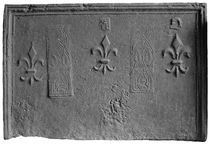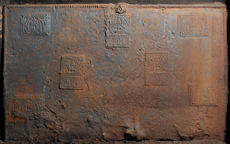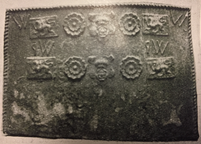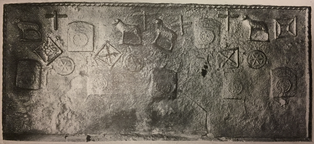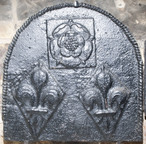-
1135
Description: Arched shape; fillet edging; top centre, date; decorative Tudor royal shield, crown, garter (motto clockwise but reversed) and supporters (dragon and greyhound); a rose to the left and a portcullis (grid of 6) to the right side of crown; the supporters stand on a horizontal compartment which, on similar firebacks, often contains the date.
Notes: There are several firebacks with the Tudor royal arms that were probably originally produced in the Spanish Netherlands, perhaps illustrating the association between England and Spain through the marriage of Henry VIII and Katherine of Aragon. The firebacks differ in several small details, such as the form and rotation of the Garter motto, the style of the crown, the positioning of the supporters in relation to the Garter, and the form and size of the rose and portcullis.
Inscription: 15 70 / HONY SOYT QVI MAL Y PENSE
Arms: English royal Tudor
- Decoration tags:
- rounded arched (shape)
- fillet (edging)
- whole carved pattern
- individual numbers
- heraldic
- armorial
- text
Manufactured: in 1570 possibly in the Wallonia area of Luxemburg.
Current location: not known.
- Attached to series:
- Tudor royal armorial firebacks
- Continental Tudor royal armorial firebacks
-
1288
Description: Arched rectangular shape with rounded corners; ovolo within fillet moulding all round; oval Tudor royal shield with garter surrounding, topped with a royal crown; dragon and greyhound supporters; initials split by crown; inscription on a fillet between legs of supporters, behind garter finial; motto on an Ionic plinth at bottom; two rectangular side panels with twisted rope edging top and side.
Notes: The supporters are those of Henry VII or Henry VIII, but the initials suggest the fireback dates from the reign of Edward VI (1547-53). John Harvo (d. c1565) was a gunfounder who has been identified as occupying Pounsley furnace, Framfield, Sussex, possibly from as early as 1547; the fireback may have been cast originally during the reign of Henry VIII (1509-47), with the initials added to an early casting using the original pattern. The detail on the armorial back is good, showing little wear, so the casting was probably made not long after the original armorial fireback. The rivets are modern.
Inscription: E R / HONY SOIT QVE MAL Y PAYNCE / Made in Sussex by John Harvo / DV ET MOVN DROI
Arms: Tudor royal - Probably Henry VIII
- Decoration tags:
- rectangular with round arch (shape)
- rope (edging)
- simple stamps
- whole carved pattern
- heraldic
- armorial
Manufactured: in the mid- to late-16th century in the Weald area of England.
Current location: not known.
- Attached to series:
- John Harvo series
- Pounsley series
-
1219
Description: Rectangular shape; twisted rope edging (top and sides); top centre, cross-shaped arrangement of four fleurs-de-lys between to crosses formed of lengths of twisted rope with single fleurs outside and beyond each of them a dagger, point upwards; to the right, a single fleur; bottom centre, a triangle formed of three lengths of twisted rope, vertex to the bottom, between two non-identical groups of three fleurs arranged in star pattern.
Notes: The style of the fleurs-de-lys associates this fireback with a series with several examples. The dagger type (approximate length 32cm) is different to others in the same series. Bishop & Miller Auctioneers, Stowmarket, 27 Jan 2022, lot 88 (£110).
- Decoration tags:
- rectangular (shape)
- rope (edging)
- simple stamps
- carved stamps
- heraldic
- apotropaic
- objects
Manufactured: in the mid- to late-16th century in the Weald area of England.
Current location: not known.
- Attached to series:
- Royal series
- Knife & Dagger stamp firebacks
- Fleur-de-lys firebacks
-
120
Description: Rectangular; rope edge (top and sides); rose and crown within a shield, stamped twice, both inverted, down centre; rectangular stamp with griffin, twice, in top corners.
Notes: Five other firebacks bearing these stamps are known: one is also in Hastings, and one, dated 1569, is at Hadlow Down, Sussex. The locations of the other three are not known. Formerly part of the Ade Collection (from Grove Hill, Hellingly, Sussex).
- Decoration tags:
- rectangular (shape)
- rope (edging)
- carved stamps
- heraldic
Manufactured: in the mid- to late-16th century in the Weald area of England.
Current location: Hastings Museum and Art Gallery, John's Place, Bohemia Road, Hastings, East Sussex, England.
Museum number: HASMG: 1952.51.11 (part of the Hastings Museum museum group)
Citation: Baines, J. M., 1958, Wealden Firebacks (Hastings Museum).
- Attached to series:
- Griffin series
-
852
Description: Rectangular; cyma recta (ogee) moulded edging (top and sides); fleur-de-lys stamp repeated three times across the upper part of the plate; a long pastry mould stamped between each pair of fleurs; above the central fleur, a small stamp, over-pressed, bearing FL below a coronet; above the right fleur, a small stamp, over-pressed, bearing a fish embowed.
Notes: The food moulds are variations of others used in the same series.
Inscription: FL
- Decoration tags:
- rectangular (shape)
- cyma reversa/ogee (edging)
- simple stamps
- carved stamps
- heraldic
- text
- animals
- objects
Manufactured: in the mid- to late-16th century possibly at Pounsley Furnace, Framfield in the Weald area of England.
Current location: not known.
- Attached to series:
- Food mould stamp firebacks
- Pounsley series
- Fleur-de-lys firebacks
-
241
Description: Rectangular; twisted rope edging (top and sides); irregular arrangement of two rectangular pastry stamps, each with a fleur de lys within fern leaves, and one with three additional fern leaves below; the smaller stamps form the four corners, with the larger stamp, three times, in a triangular pattern between.
Notes: Various excrescences on the plate were probably the result of careless pouring of the metal during casting.
- Decoration tags:
- rectangular (shape)
- rope (edging)
- simple stamps
- objects
Manufactured: in the mid- to late-16th century possibly at Pounsley Furnace, Framfield in the Weald area of England.
Current location: in private hands Kensington and Chelsea, London, England.
- Attached to series:
- Pounsley series
- Food mould stamp firebacks
-
1196
Description: Quasi-rectangular shape; twisted rope edging (top and sides); 'W' in top corners, between which are a line of five stamps: a 'renaissance' style shield bearing a rose and crown, between two rose stamps, and a rectangular stamp bearing a griffin at each end; below each dragon stamp, a 'W' preceded by a reversed 'P'; below this, the line of five stamps repeated.
Notes: The shield and griffin stamps have been seen on other firebacks, associating them with a common producer; the 'W' may be apotropaic and symbolic of the Virgin Mary. Illustration from Christy 1908 who noted the fireback at Guildford, Surrey.
Inscription: W W / qW qW
- Decoration tags:
- rectangular (shape)
- rope (edging)
- simple stamps
- carved stamps
- individual letters
- heraldic
- apotropaic
- animals
Manufactured: in the mid- to late-16th century in the Weald area of England.
Current location: not known.
- Attached to series:
- Griffin series
-
1194
Description: Rectangular shape; twisted rope or strap edging (top and sides); semi-random arrangement of three stamps interspersed with rope crosses and rope 'squares' with saltires or linked smaller squares within; low centre, a crowned rose-en-soleil stamp repeated, more or less regularly, five times across the width of the fireback; above, four circular butter mould stamps with a hexagonal design, between which are two rope squares with saltires and, to the left, a rope square containing a smaller square with its corners linked to the corners of the outer square; above, a horned sheep standing on a base repeated four times, between which are two crowned rose-en-soleil stamps and four rope crosses, with a square-within-a-square at the right end.
Notes: The rose-en-soleil was the badge of King Edward IV and, thus, a Yorkist symbol. It, together with the butter mould and rope squares, are seen on other firebacks associating them with the same producer/foundry. A ram is the crest of the Gage family of West Firle, for many centuries major landholders in Sussex; it is also the crest of the Clothworkers' Company of London. Formerly at Heringdales/Heronsdale Manor, Waldron, East Sussex, which, however, was not a Gage property. Illustration from Christy 1908.
- Decoration tags:
- rectangular (shape)
- rope (edging)
- simple stamps
- carved stamps
- heraldic
- apotropaic
- animals
- objects
Manufactured: in the mid- to late-16th century possibly at Pounsley Furnace, Framfield in the Weald area of England.
Current location: Wickham Manor, Winchelsea, East Sussex, England.
Museum number: NT/WMF/M/007 (part of the National Trust museum group)
Citation: Gardner, J. S., 1898, 'Iron Casting in the Weald', Archaeologia, 56, 1, pp. 133-164.
- Attached to series:
- Pounsley series
- Food mould stamp firebacks
- Rose-en-soleil series
-
1111
Description: Arched shape; twisted rope edging (top and sides); top centre, over-pressed Tudor rose stamp on a square block; large diamond-shaped stamp with fleur-de-lys repeated each side below rose, both over-pressed.
Notes: The diamond-shaped stamp has been seen on other firebacks; one of the stamps appears to have been repositioned twice before casting.
- Decoration tags:
- rounded arched (shape)
- rope (edging)
- simple stamps
- carved stamps
- heraldic
- objects
Manufactured: in the mid- to late-16th century in the Weald area of England.
Current location: in private hands, Crowborough, East Sussex, England.
- Attached to series:
- Large diamond fleur series
- Fleur-de-lys firebacks
-
1114
Description: Rectangular; twisted rope edging (top and two-thirds down sides); rope length across each top corner.
Notes: The twisted rope lengths are particularly well defined.
- Decoration tags:
- rectangular (shape)
- rope (edging)
- simple stamps
- objects
Manufactured: in the mid- to late-16th century in the Weald area of England.
Current location: in private hands, Crowborough, East Sussex, England.
- Attached to series:
- Rope design firebacks
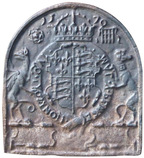
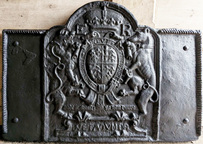
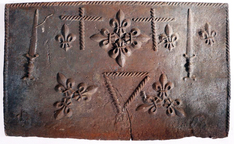
.jpg)
